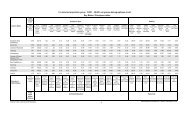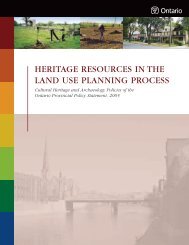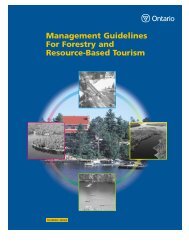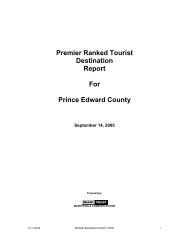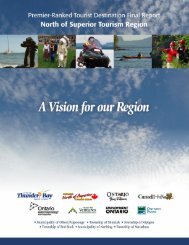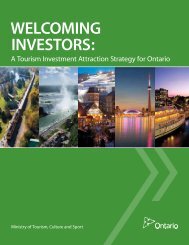Factors Influencing Visitor's Choices of Urban Destinations in North ...
Factors Influencing Visitor's Choices of Urban Destinations in North ...
Factors Influencing Visitor's Choices of Urban Destinations in North ...
Create successful ePaper yourself
Turn your PDF publications into a flip-book with our unique Google optimized e-Paper software.
3. The cognitive perspective <strong>in</strong>volves categoriz<strong>in</strong>g attractions accord<strong>in</strong>g to “touristperceptions and experiences.” Cognitive perspective is <strong>in</strong>ter-mixed with the ideographicperspective. For example, “campground” is an ideographic attraction. However,“camp<strong>in</strong>g” is more <strong>of</strong> an experience where participation makes these sites more than justsites to be observed.Lew applies this framework to the previous studies. Lew uses Piperoglou (1966) andFerrario’s (1976) evaluations <strong>of</strong> tourist attractions <strong>of</strong> Western Greece and South Africa toillustrate the usefulness <strong>of</strong> the proposed framework.“Tourist Attraction Systems”Leiper (1990) provides a tourism framework/model def<strong>in</strong>ed as an empirical relationshipbetween a tourist, a site and a marker—a piece <strong>of</strong> <strong>in</strong>formation about a site. In his paper,Leiper <strong>in</strong>troduces a more complete def<strong>in</strong>ition <strong>of</strong> an attraction system by synthesiz<strong>in</strong>g thedef<strong>in</strong>itions from the past literature: “A tourist attraction is a system compris<strong>in</strong>g 3elements: a tourist or human element, a nucleus or central element, and a marker <strong>of</strong><strong>in</strong>formative element. A tourist attraction comes <strong>in</strong>to existence when all 3 elements areconnected.”Travellers and Tourists: are people who are away from home to the extent that theirbehaviour is motivated by leisure-related factors. This avoids any questions related to thepurpose <strong>of</strong> the trip/visit. The touristic behaviour is related to a search for satisfy<strong>in</strong>gleisure away from home. Touristic leisure means a search for suitable attractions and asearch for personal experience <strong>of</strong> attraction systems’ nuclear elements. Tourists have arange <strong>of</strong> recreational and creative needs that need to be satisfied. This implies a very widerange <strong>of</strong> attractions.Nucleus: refers to a central element <strong>in</strong> a tourist attraction system; it might be any featureor characteristic <strong>of</strong> a place that a traveller wants to visit. Leiper relies on the threecategories <strong>of</strong> nuclear elements that were developed by Lew (1987). (Please see thediscussion above.)Markers: are items <strong>of</strong> <strong>in</strong>formation about any attraction that is a potential nuclear element<strong>in</strong> a tourist attraction. Leiper <strong>in</strong>troduces three categories <strong>of</strong> markers—generat<strong>in</strong>g markers,transit markers, and contiguous markers. Generat<strong>in</strong>g markers are referred to the<strong>in</strong>formation received before sett<strong>in</strong>g <strong>of</strong>f to an attraction site/nucleus (i.e. <strong>in</strong>formationreceived via <strong>in</strong>ternet or newspaper). Transit markers are related to the <strong>in</strong>formation founddur<strong>in</strong>g the trip lead<strong>in</strong>g to the nucleus to which this <strong>in</strong>formation refers. Contiguousmarkers are related to the <strong>in</strong>formation found at the attraction site/nucleus.“Tourism Attraction Systems: Explor<strong>in</strong>g Cultural Behaviour”Richard (2002) builds on Leiper’s model and provides empirical evidence to support thisframework. His paper discusses the results from the survey taken <strong>in</strong> 2000 <strong>of</strong> 6,000tourists travell<strong>in</strong>g to 43 cultural attractions <strong>in</strong> Europe and three <strong>in</strong> Australia. The culturalattractions <strong>in</strong>clude museums, monuments, art galleries, heritage centers, perform<strong>in</strong>g artvenues, and festivals. Respondents were asked at what po<strong>in</strong>t they had made their decisionto visit the <strong>in</strong>terview location (“before leav<strong>in</strong>g home,” “dur<strong>in</strong>g the trip,” “when I arrivedto the area”), to what extent the attraction had <strong>in</strong>fluenced their visit, motivation for the43



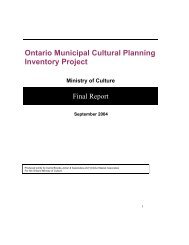
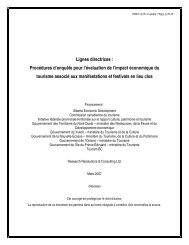
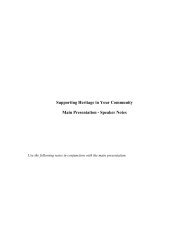
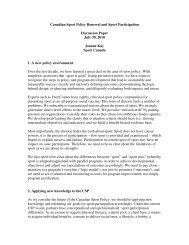
![THIS AGREEMENT made this [date], between [name of owner] (the ...](https://img.yumpu.com/49827605/1/158x260/this-agreement-made-this-date-between-name-of-owner-the-.jpg?quality=85)

